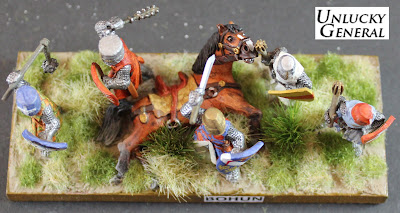TABLE-TOP: Building Part 1
 |
| The Royal army edge of the battle field complete to basic construction |
In approaching the build I have layered the foam, cut to the contours as laid out in my map (see previous TABLE-TOP post) and after basic construction I will sculpt the slopes back from the edges of each sheet. In approaching this particular build the first thing I needed to do was determine what thicknesses of foam to deal with.
Whilst the contours represent 50' in the real world, if I were to work strictly to scale at 28mm then each level of foam would be 230mm thick and the highest point of my table would stand over 1.8 meters or so (over 6') and I'd need a ladder to reach the top. So that needed scaling back somewhat. With foam thicknesses of 25mm the highest elevation will stand 225mm (10') from the base boards - this includes the first 25mm layer as ground level. This should allow representation of the gradient and an adequate visual 'feel' for the ground. I admit that at current cost of materials, the less foam the better but the table needs to be playable and stability for figures is a consideration across the rises and fall of the ground.
 |
| Adding level 4 using off cuts where I can. |
SET-PIECE THEORY
This is the first time I have embarked on anything other than modular terrain systems. Normally a wargamer wants to use the scenery he buys or builds again and again and construct variable battlefields for different games. I reckoned this time; however, that if I'm going to take this much time and make this much effort to research and build an accurate army over several years which fought one battle then the least I can do is dedicate a small amount of my attention to the ground upon which that army fought. As with other projects of mine which are not so far advanced (Quebec and Balaclava) this is how I will be approaching my hobby over the next few years. I am fortunate that I have the space for building and storage.
SCRAPS
Not quite all of the foam is new and I have several thickness of scrap foam stored in my garage which I have put to good use. Particularly for the bottom layers, it doesn't even matter that some levels have only partial coverage - so long as the outer edges are established and there is sufficient coverage to base the next layer on top. I have been quite free with my off-cuts - fitting them into external and internal gaps with any residuals cracks and spaces to be filled with expanding spray-foam prior to the sculpting phase.
GLUE
Whilst I had bought some expensive (AUD17.00) spray glue there is just no substitute for wood glue or white glue. Any brand will do - the cheaper the better - and it provides plenty of coverage, a workable and reasonable drying time and a product for which there just is no adequate substitute. Each layer does require some weighting down to ensure a good joint - flat and even - so I'm using tool boxed, cans and just about anything heavy enough to get the job done.
CUTTING
I use a small hand saw (like a blade with a handle) for small,quick and dirty cutting but primarily I've been using my hot-wire cutter which I made myself from instructions I downloaded off the Internet. It's a bow style construction of wood, two swivel arms bolted to a cross piece - the arms holding the electrical connections to the fuse wire and kept tense by a spring tension connection aft of the cross piece. I'm not going to do into any detail as electronics is not my forte and I refuse to be responsible for anyone else: it's taken me some time to be comfortable with my handy work - in fact, I'm quite proud of myself because it works like a dream. It's connected to mains power through an old model railway transformer.
I found that I had to sand smooth the edges of the ply bases as the wire will run into snags otherwise. To ensure an even cut (very important as the layers gain thickness) I sandwich the ply base with a spare section of ply in perfect alignment and then run the hot wire ensuring it touches both boards to get that dead straight cut.
 |
| My home made beast |
I wear a chemical double filter respirator when cutting the foam - it lets off a deal of noxious fumes which tend to hang about a bit so I don't feel the need to off the mask for a while after each use. I am working in my garage and have the door up and entrance open to maximise ventilation. This is not otherwise an 'indoors' job.



Comments